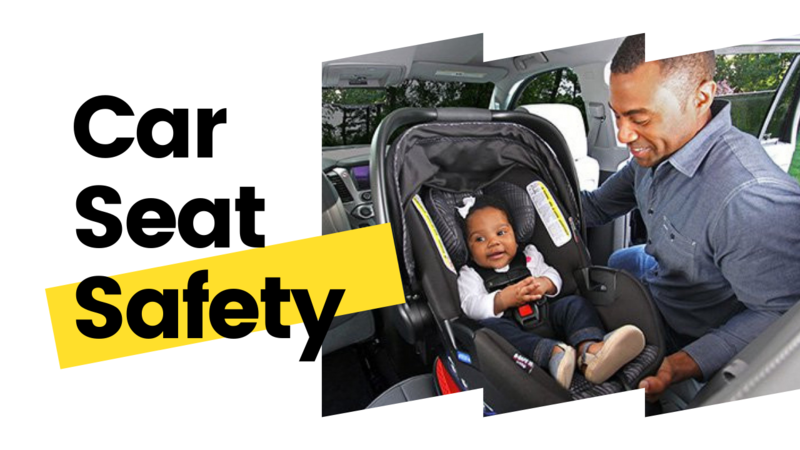The No No’s and The Must Know’s of Car Seat Safety

The No No’s and The Must Know’s of Car Seat Safety
According to the CDC, motor vehicle injuries are a leading cause of death among children in the U.S. Correctly used car seats, booster seats and seat belts reduces serious and fatal injuries by up to 80 percent. In addition, unrestrained children in car crashes are 7 times more likely to suffer a Traumatic Brain Injury vs. children who were in age and size appropriate restraints. (https://www.cdc.gov/motorvehiclesafety/child_passenger_safety/pubs.html)
Let’s face it, we are often in a rush to get to where we are going. We also are very distracted at times by our devices, our schedule for the day, and every other thought that may be on our minds. We are busy! We can never be too busy, too preoccupied, too much in a rush for is the safety of the children in our vehicles. Many people are not aware of the dangers that not using, or incorrectly using car seats can cause.
Important Information and Tips about Car Seat Safety That You May Not Know:
- Never use a used car seat: There is no way of confirming that the car seat has never been involved in a car crash. It’s not like car seats come with “car fax reports”. The seat may be expired. What? Yes. Car seats do in fact have expiration dates. Car seats typically expire after 6 years of the date of manufacture. You can find a car seat’s expiration date on a sticker located on the car seat. Why do car seats expire? Car seats expire for a number of reasons. 1. Wear & Tear 2. Improved Technology 3. Recalls 4. Replacement parts 5. It can be past the safety-tested lifespan.
- Do not use a car seat after any type of car crash: If the car seat has been involved in a crash it may be rendered unsafe even if a child was not in the seat at the time of the crash. The NHTSA suggests that minor fender benders may be an exception. When in doubt, you should stop using the car seat immediately because it is difficult to know whether or not the car seat poses a safety risk. If you do need to replace the car seat, some auto insurance companies will reimburse you for the cost of a new one. It’s imperative that the car seat is discarded properly. You can look up recycling programs that may offer a voucher towards the purchase of a seat. It is important that if you throw out a damaged car seat to cut the straps or you can write on it “not safe, do not use”. You want to ensure this seat won’t be used by someone else.
- Safety is paramount: Typically, no one goes to school for car seat safety, so it is understandable that many people do not know some essential tips for buckling a child into their car seat.
- First and foremost: Read your car seat manual in its entirety. It gives step by step instructions on how to install the seat properly. If you do not have a manual, look up the car seat brand and model number to find the manual on the manufacturers website. There is so much information in there that is often overlooked or ignored.
- Have your car seat inspected to ensure it is installed properly. The NHTSA website has a certified inspector locations. You just enter your zip code to find a location near you.
- Children should not wear any bulky clothing, or jackets in the car seat. Upon crash, impact they can slip out of the restraints.
- Don’t add any accessories that are not certified for use in your specific car seat. As a rule of thumb, do not use anything that did not come with the original car seat packaging. These products can affect the safety of the child.
- Be sure that the harness straps fit snugly. There should be no slack to the straps. If you can fit a finger underneath the strap it is not properly tightened. The “pinch test” is a good method to determine the proper fit. If you try to pinch the harness horizontally you should not be able to pinch any of the material together. If you can, that indicates the harness is not properly tightened.
- The chest clip should be even with the child’s arm pits.
- The car does not move until everyone is properly buckled in.
(Image from: https://www.nhtsa.gov/equipment/car-seats-and-booster-seats#install-inspection)
- You can register your car seat to receive recalls and safety notifications about your car seat model: The manufacturer of your car seat has a form in which you can fill out to receive updates about your car seat. This is the eco-friendly version of the car seat registration card that car seats come with that many consumers tend to discard. The National Highway Traffic Safety Administration also known as NHTSA has a drop down menu where you can select your car seat manufacturer and it will bring you to that manufacturer’s car seat registration form.
Pictured is an example of Graco’s Car Seat Registration Form. (Image from: www.gracobaby.com/ProductRegistrationCarSeatsView
Another helpful resource on NHSTA is the Car Seat Finder feature. This feature allows you to enter a child’s birthdate, height, and weight. It then populates which type of car seat the child should be using. A list of suggested car seats that align with the results from the finder also populates. From this list you can see different brands of car seats that are on the market and follow links to see the reviews for each type of car seat.
Car Seat Finder Tool on NHSTA’s website (https://www.nhtsa.gov/equipment/car-seats-and-booster-seats#resources)
Additional Car Seat Safety Resources: (https://www.nhtsa.gov/equipment/car-seats-and-booster-seats#resources)

